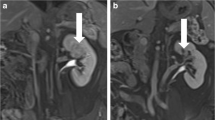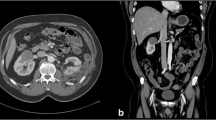Abstract
Purpose
To report on the first short-term oncologic outcomes of percutaneous irreversible electroporation for small renal masses.
Methods
Patients with cT1a renal masses treated with irreversible electroporation from April 2013 through December 2016 were reviewed. Small, low complexity tumors were generally selected for irreversible electroporation using the NanoKnife® System (Angiodynamics, Latham, NY, USA). Surveillance imaging was performed post-operatively, and survival analysis was completed using the Kaplan–Meier method.
Results
A total of 42 tumors in 41 patients underwent irreversible electroporation. Mean tumor size was 2.0 cm with a median R.E.N.A.L nephrometry score of 5. Twenty-nine patients (71%) were discharged the same day of the procedure and no major (Clavien grade II or higher) intraoperative or post-operative complications occurred. Initial treatment success rate was 93%; our three failures (7%) underwent salvage radiofrequency ablation. With a mean follow-up of 22 months, 2-year local recurrence-free survival was 83% for patients with biopsy confirmed renal cell carcinoma, 87% with biopsy confirmed or a history of renal cell carcinoma, and 92% for the intent-to-treat cohort.
Conclusions
Although with low morbidity, in comparison to extirpation and conventional thermal ablation technologies, irreversible electroporation has suboptimal short-term local disease control results in this series of small, low complexity tumors. Larger series and longer follow-up will determine the durability of this modality.

Similar content being viewed by others
References
Tracy CR, Raman JD, Donnally C, Trimmer CK, Cadeddu JA (2010) Durable oncologic outcomes after radiofrequency ablation: experience from treating 243 small renal masses over 7.5 years. Cancer 116(13):3135–3142
Psutka SP, Feldman AS, McDougal WS, McGovern FJ, Mueller P, Gervais DA (2013) Long-term oncologic outcomes after radiofrequency ablation for T1 renal cell carcinoma. Eur Urol 63(3):486–492
Olweny EO, Park SK, Tan YK, Best SL, Trimmer C, Cadeddu JA (2012) Radiofrequency ablation versus partial nephrectomy in patients with solitary clinical T1a renal cell carcinoma: comparable oncologic outcomes at a minimum of 5 years of follow-up. Eur Urol 61(6):1156–1161
Kim EH, Tanagho YS, Saad NE, Bhayani SB, Figenshau RS (2014) Comparison of laparoscopic and percutaneous cryoablation for treatment of renal masses. Urology 83(5):1081–1087
Caputo PA, Ramirez D, Zargar H, Akca O, Andrade HS, O’Malley C, Remer EM, Kaouk JH (2015) Laparoscopic cryoablation for renal cell carcinoma: 100-month oncologic outcomes. J Urol 194(4):892–896
Atwell TD, Carter RE, Schmit GD, Carr CM, Boorjian SA, Curry TB, Thompson RH, Kurup AN, Weisbrod AJ, Chow GK, Leibovich BC, Callstrom MR, Patterson DE (2012) Complications following 573 percutaneous renal radiofrequency and cryoablation procedures. J Vasc Interv Radiol 23(1):48–54
Best SL, Park SK, Youssef RF, Yaacoub RF, Olweny EO, Tan YK, Trimmer C, Cadeddu JA (2012) Long-term outcomes of renal tumor radio frequency ablation stratified by tumor diameter: size matters. J Urol 187(4):1183–1189
Park BK, Kim CK (2009 Sep) Complications of image-guided radiofrequency ablation of renal cell carcinoma: causes, imaging features and prevention methods. Eur Radiol 19(9):2180–2190
Lay AH, Faddegon S, Olweny EO, Morgan M, Lorber G, Trimmer C, Leveillee R, Cadeddu JA, Gahan JC (2015) Oncologic efficacy of radio frequency ablation for small renal masses: clear cell vs papillary subtype. J Urol 194(3):653–657
Davalos RV, Mir ILM, Rubinsky B (2005 Feb) Tissue ablation with irreversible electroporation. Ann Biomed Eng 33(2):223–231
Gehl J (2003 Apr) Electroporation: theory and methods, perspectives for drug delivery, gene therapy and research. Acta Physiol Scand 177(4):437–447
Edd JF, Horowitz L, Davalos RV, Mir LM, Rubinsky B (2006) In vivo results of a new focal tissue ablation technique: irreversible electroporation. IEEE T Bio-Med Eng 53(7):1409–1415
Kingham TP, Karkar AM, D’Angelica MI, Allen PJ, Dematteo RP, Getrajdman GI, Sofocleous CT, Solomon SB, Jarnagin WR, Fong Y (2012) Ablation of perivascular hepatic malignant tumors with irreversible electroporation. J Am Coll Surg 215(3):379–387
Martin RCG, Kwon D, Chalikonda S, Sellers M, Kotz E, Scoggins C, McMasters KM, Watkins K (2015 Sep) Treatment of 200 locally advanced (stage III) pancreatic adenocarcinoma patients with irreversible electroporation: safety and efficacy. Ann Surg 262(3):486–494
Ting F, Tran M, Böhm M, Siriwardana A, Van Leeuwen PJ, Haynes A-M, Delprado W, Shnier R, Stricker PD (2016) Focal irreversible electroporation for prostate cancer: functional outcomes and short-term oncological control. Prostate Canc P D 19(1):46–52
Deodhar A, Monette S, Single GW, Hamilton WC, Thornton R, Maybody M, Coleman JA, Solomon SB (2011) Renal tissue ablation with irreversible electroporation: preliminary results in a porcine model. Urology 77(3):754–760
Tracy CR, Kabbani W, Cadeddu JA (2011) Irreversible electroporation (IRE): a novel method for renal tissue ablation. BJU Int 107(12):1982–1987
Olweny EO, Kapur P, Tan YK, Park SK, Adibi M, Cadeddu JA (2013) Irreversible electroporation: evaluation of nonthermal and thermal ablative capabilities in the porcine kidney. Urology 81(3):679–684
Pech M, Janitzky A, Wendler JJ, Strang C, Blaschke S, Dudeck O, Ricke J, Liehr U-B (2011) Irreversible electroporation of renal cell carcinoma: a first-in-man phase I clinical study. Cardiovasc Inter Rad 34(1):132–138
Wendler JJ, Ricke J, Pech M, Fischbach F, Jürgens J, Siedentopf S, Roessner A, Porsch M, Baumunk D, Schostak M, Köllermann J, Liehr U-B (2015) First delayed resection findings after irreversible electroporation (IRE) of human localised renal cell carcinoma (RCC) in the IRENE Pilot Phase 2a trial. Cardiovasc Inter Rad 4(39):239–250.
Diehl SJ, Rathmann N, Kostrzewa M, Ritter M, Smakic A, Schoenberg SO, Kriegmair MC (2016) Irreversible electroporation for surgical renal masses in solitary kidneys: short-term interventional and functional outcome. J Vasc Interv Radiol 27(9):1407–1413
Trimmer CK, Khosla A, Morgan M, Stephenson SL, Ozayar A, Cadeddu JA (2015 Oct) Minimally invasive percutaneous treatment of small renal tumors with irreversible electroporation: a single-center experience. J Vasc Interv Radiol 26(10):1465–1471
Kutikov A, Uzzo RG (2009) The R.E.N.A.L nephrometry score: a comprehensive standardized system for quantitating renal tumor size, location and depth. J Urol 182(3):844–853
Donat SM, Diaz M, Bishoff JT, Coleman JA, Dahm P, Derweesh IH, Herrell SD, Hilton S, Jonasch E, Lin DW, Reuter VE, Chang SS (2013) Follow-up for clinically localized renal neoplasms: AUA guideline. J Urol 190:407–416
Dindo D, Demartines N, Clavien P-A (2004 Aug) Classification of surgical complications: a new proposal with evaluation in a cohort of 6336 patients and results of a survey. Ann Surg 240(2):205–213
Campbell SC, Novick AC, Belldegrun A, Blute ML, Chow GK, Derweesh IH, Faraday MM, Kaouk JH, Leveillee RJ, Matin SF, Russo P, Uzzo RG, Practice Guidelines Committee of the American Urological Association (2009) Guideline for management of the clinical T1 renal mass. J Urol 182:1271–1279
Ljungberg B, Bensalah K, Canfield S, Dabestani S, Hofmann F, Hora M, Kuczyk MA, Lam T, Marconi L, Merseburger AS, Mulders P, Powles T, Staehler M, Volpe A, Bex A (2015) EAU guidelines on renal cell carcinoma: 2014 update. Eur Urol 67(5):913–924
Crispen PL, Boorjian SA, Lohse CM, Sebo TS, Cheville JC, Blute ML, Leibovich BC (2008) Outcomes following partial nephrectomy by tumor size. J Urol 180(5):1912–1917
Balageas P, Cornelis F, Le Bras Y, Hubrecht R, Bernhard JC, Ferrière JM, Ravaud A, Grenier N (2013) Ten-year experience of percutaneous image-guided radiofrequency ablation of malignant renal tumours in high-risk patients. Eur Radiol 23(7):1925–1932
Zargar H, Samarasekera D, Khalifeh A, Remer EM, O’Malley C, Akca O, Autorino R, Kaouk JH (2015 Apr) Laparoscopic vs percutaneous cryoablation for the small renal mass: 15-year experience at a single center. Urology 85(4):850–855
Author information
Authors and Affiliations
Corresponding author
Ethics declarations
Author contributions
NEC: Data collection, Data analysis, Manuscript writing and editing. IS: Data collection, Data analysis, Manuscript writing and editing. AHL: Data collection. MSCM: Data collection, Manuscript writing. AO: Data collection. CT: Protocol/project development. JAC: Protocol/project development, Data analysis, Manuscript editing.
Conflict of interest
The authors declare that they have no conflict of interest.
Extra-institutional funding
None.
Ethical approval
All procedures performed in this study were in accordance with the ethical standards of the Institutional Review Board and with the 1964 Helsinki declaration and its later amendments.
Rights and permissions
About this article
Cite this article
Canvasser, N.E., Sorokin, I., Lay, A.H. et al. Irreversible electroporation of small renal masses: suboptimal oncologic efficacy in an early series. World J Urol 35, 1549–1555 (2017). https://doi.org/10.1007/s00345-017-2025-5
Received:
Accepted:
Published:
Issue Date:
DOI: https://doi.org/10.1007/s00345-017-2025-5




